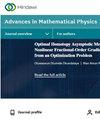A Bayesian-Weighted Inverse Gaussian Regression Model with Application to Seismological Data
IF 1.1
4区 物理与天体物理
Q3 PHYSICS, MATHEMATICAL
引用次数: 0
Abstract
Developing an efficient model for analyzing right-skewed positive observations has a long history, and many authors have attempt in this direction. This is because the common analytic modeling procedures such as linear regression are often inappropriate for such data and leads to inadequate results. In this article, we proposed a new model for regression analysis of the right-skewed data by assuming the weighted inverse Gaussian, as a great flexible distribution, for response observations. In the proposed model, the complementary reciprocal of the location parameter of response variable is considered to be a linear function of the explanatory variables. We developed a fully Bayesian framework to infer about the model parameters based on a general noninformative prior structure and employed a Gibbs sampler to derive the posterior inferences by using the Markov chain Monte Carlo methods. A comparative simulation study is worked out to assess and compare the proposed model with other usual competitor models, and it is observed that efficiency is quite satisfactory. A real seismological data set is also analyzed to explain the applicability of the proposed Bayesian model and to access its performance. The results indicate to the more accuracy of proposed regression model in estimation of model parameters and prediction of future observations in comparison to its usual competitors in literature. Particularly, the relative prediction efficiency of the proposed regression model to the inverse Gaussian and log-normal regression models has been obtained to be 1.16 and 64, respectively, for the real-world example discussed in this paper.贝叶斯加权高斯反回归模型在地震资料中的应用
建立一个有效的模型来分析右偏正观测值已经有很长的历史了,许多作者都在这个方向上进行了尝试。这是因为常见的分析建模程序,如线性回归,往往不适合这样的数据,导致不充分的结果。在本文中,我们提出了一个新的模型来回归分析右偏数据,假设加权逆高斯分布,作为一个很大的灵活分布,对响应的观察。在该模型中,响应变量的位置参数的互补倒数被认为是解释变量的线性函数。我们开发了一个基于一般非信息先验结构的全贝叶斯框架来推断模型参数,并使用Gibbs采样器通过马尔可夫链蒙特卡罗方法推导后验推断。通过对比仿真研究,对所提出的模型与其他常用的竞争模型进行了评估和比较,结果表明,该模型的效率是令人满意的。通过对实际地震数据集的分析,说明了贝叶斯模型的适用性和性能。结果表明,与文献中常用的回归模型相比,该模型在模型参数估计和未来观测值预测方面具有更高的准确性。特别是,对于本文讨论的实际例子,所提出的回归模型相对于高斯逆回归模型和对数正态回归模型的相对预测效率分别为1.16和64。
本文章由计算机程序翻译,如有差异,请以英文原文为准。
求助全文
约1分钟内获得全文
求助全文
来源期刊

Advances in Mathematical Physics
数学-应用数学
CiteScore
2.40
自引率
8.30%
发文量
151
审稿时长
>12 weeks
期刊介绍:
Advances in Mathematical Physics publishes papers that seek to understand mathematical basis of physical phenomena, and solve problems in physics via mathematical approaches. The journal welcomes submissions from mathematical physicists, theoretical physicists, and mathematicians alike.
As well as original research, Advances in Mathematical Physics also publishes focused review articles that examine the state of the art, identify emerging trends, and suggest future directions for developing fields.
 求助内容:
求助内容: 应助结果提醒方式:
应助结果提醒方式:


